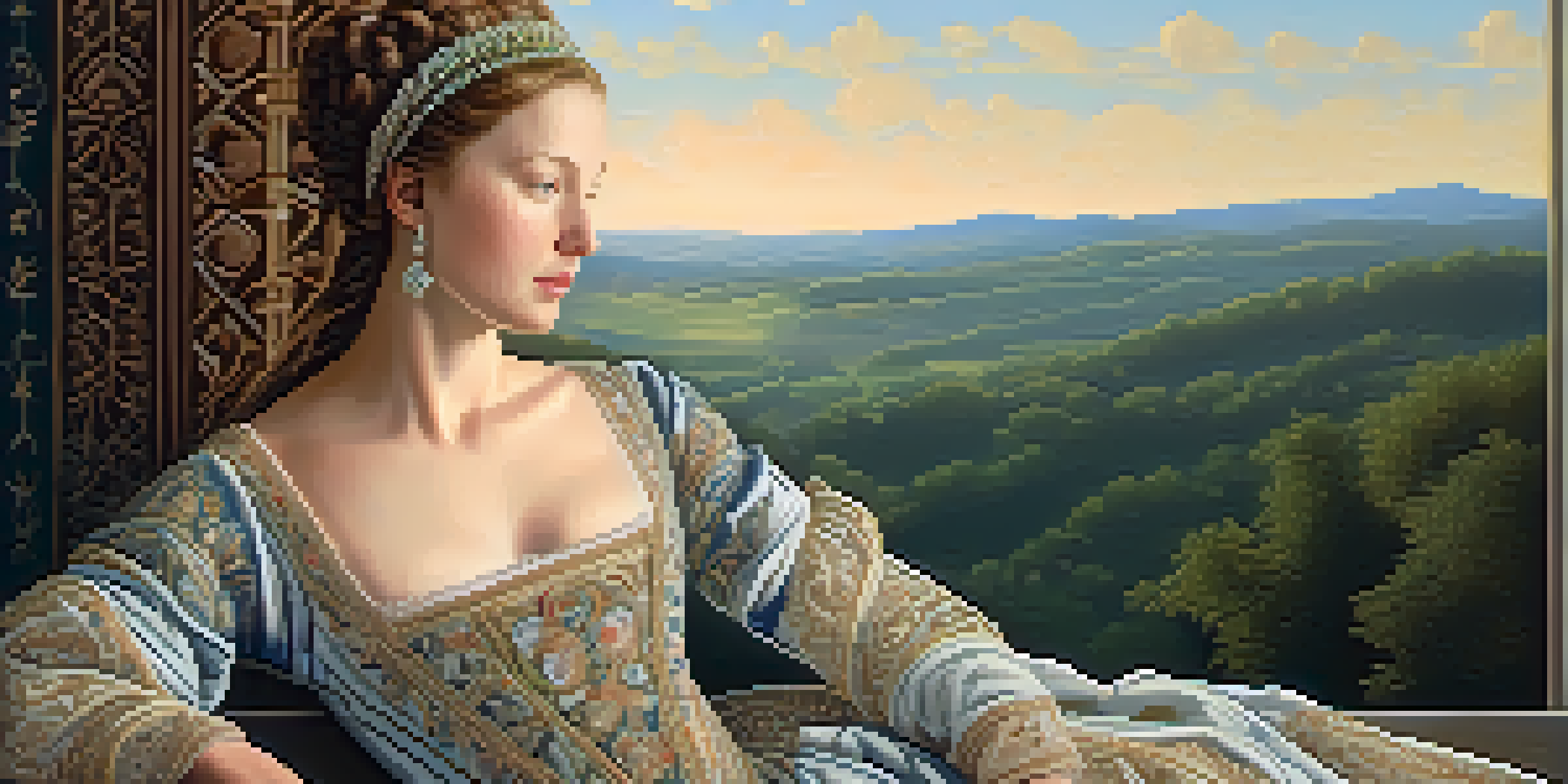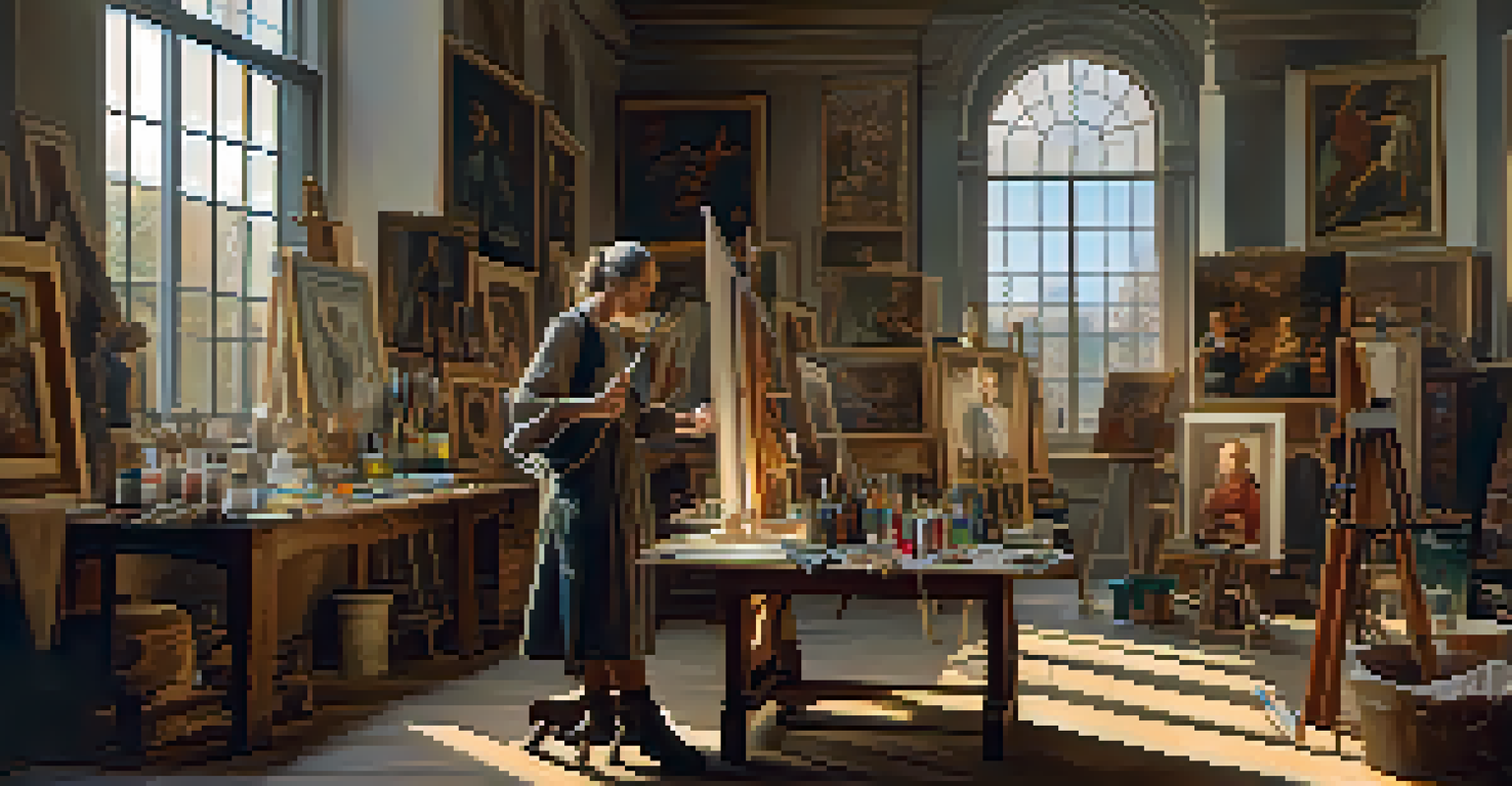Renaissance Portraits: Shifts in Style and Technique Explained

Understanding the Renaissance and Its Artistic Context
The Renaissance, a cultural movement spanning the 14th to 17th centuries, marked a profound shift in art, philosophy, and science. This period celebrated humanism, emphasizing individual potential and achievements, which significantly influenced artistic expression. Artists began to focus on realistic representations of human figures, diverging from the stylized forms of the Middle Ages.
Art is the most beautiful of all lies.
During this time, the revival of classical themes and techniques played a pivotal role in shaping portraiture. Artists sought inspiration from ancient Greek and Roman works, leading to a renewed interest in anatomy, proportion, and perspective. This shift not only elevated the status of artists but also transformed the way society viewed portraits as reflections of identity and status.
As we explore Renaissance portraits, it's essential to recognize how these artistic changes mirrored broader societal transformations. The emergence of wealthy patrons, such as the Medici family, allowed artists the freedom to experiment with new styles and techniques, setting the stage for the masterpieces that would define the era.
Key Characteristics of Early Renaissance Portraits
Early Renaissance portraits, often characterized by their flatness and lack of depth, laid the groundwork for future developments in the genre. Artists like Giotto and Masaccio began to imbue their subjects with a sense of realism, yet their works still retained elements of medieval art. The use of tempera paint and wooden panels limited the textural possibilities, resulting in portraits that were somewhat rigid and less dynamic.

Despite these limitations, early Renaissance artists made significant strides in capturing the likeness and personality of their subjects. They employed techniques such as chiaroscuro, which contrasts light and shadow, to add dimension to their portraits. This early experimentation would pave the way for more sophisticated approaches in the later stages of the Renaissance.
Renaissance Redefined Portraits
The Renaissance marked a significant shift in portraiture, emphasizing realism and individualism while incorporating classical themes.
Moreover, the inclusion of symbolic elements in these portraits added layers of meaning and context. For instance, objects like books or globes often represented knowledge and power, reflecting the individual’s status in society. This combination of realism and symbolism became a hallmark of Renaissance portraiture.
The Rise of Naturalism in High Renaissance Portraits
By the High Renaissance, artists were embracing naturalism, striving for lifelike representations that captured the essence of their subjects. This period saw the emergence of iconic figures like Leonardo da Vinci and Raphael, who transformed portraiture with their innovative techniques. Da Vinci's 'Mona Lisa' exemplifies this shift, featuring intricate details and an enigmatic expression that invites viewers to connect with the subject on a personal level.
Every artist dips his brush in his own soul, and paints his own nature into his pictures.
The use of oil paints became more prevalent during this time, allowing for richer colors and greater depth of texture. Artists could layer their paint to create subtle gradations of tone and a more realistic portrayal of skin, hair, and fabric. This technical advancement brought portraits to life, enhancing their emotional impact and inviting viewers to engage with the subject's story.
Additionally, the incorporation of atmospheric perspective, where background elements fade into a soft blur, created a sense of space and realism. This technique not only grounded the subject within a believable environment but also added to the overall composition, making the portraits more dynamic and engaging for the audience.
The Impact of Individualism in Portraiture
As the Renaissance progressed, the concept of individualism became increasingly significant in portraiture. Artists began to depict their subjects not just as members of society but as unique individuals with distinct personalities and emotions. This shift was reflected in the way artists like Titian and Holbein portrayed their sitters, capturing their character and essence with remarkable precision.
The psychological depth in these portraits encouraged viewers to engage with the subject on a more personal level. The nuanced expressions and thoughtful poses conveyed a sense of introspection, inviting the audience to ponder the complexities of the human experience. This emphasis on individualism marked a departure from earlier, more generalized representations.
Symbolism Enriches Portraits
Artists used symbolism and allegory in portraits to convey deeper meanings, reflecting the sitter's identity and societal values.
Additionally, the rise of self-portraits during this period showcased the artist's own identity and perspective. Artists like Rembrandt embraced this trend, using self-portraits as a means of exploring their own emotions and experiences. This merging of personal and artistic identity further solidified the role of the artist as an individual in their own right.
Symbolism and Allegory in Renaissance Portraits
Symbolism played a crucial role in Renaissance portraiture, as artists often included objects and motifs to convey deeper meanings. These symbols could represent the sitter's profession, virtues, or aspirations, enriching the narrative of the portrait. For example, a painter might include a palette to signify their artistic prowess or a book to represent wisdom and learning.
Allegorical elements also found their way into portraits, allowing artists to explore complex themes and ideas. The use of allegory enabled them to communicate moral lessons or societal values subtly, making the artwork not just a representation of the individual but a commentary on broader human experiences. This multifaceted approach to portraiture added layers of intrigue and depth.
Moreover, the careful arrangement of these symbols within the composition became an art form in itself. Artists meticulously placed objects to guide the viewer's eye and create a harmonious balance. This thoughtful interplay of symbolism and composition showcased the artist's skill and intention, making each portrait a rich tapestry of meaning.
The Role of Patrons in Shaping Portrait Styles
The patronage system significantly influenced the evolution of portraiture during the Renaissance. Wealthy individuals and families, such as the Medicis and Sforzas, commissioned portraits to showcase their power and status. This demand for personalized artworks led artists to adapt their styles and techniques to meet the expectations of their patrons, resulting in a diverse range of portrait styles.
Patrons often had specific requests regarding the portrayal of their likeness, which could dictate the level of naturalism or idealization in the final work. For instance, some patrons preferred a more flattering representation, while others sought a realistic depiction that highlighted their unique features. This dynamic between artist and patron created a fascinating interplay of creativity and commerce.
Patrons Shaped Artistic Styles
Wealthy patrons influenced the evolution of portrait styles by commissioning works that aligned with their personal and social aspirations.
Additionally, the commissioning of portraits for public display underscored the importance of social status in Renaissance society. Portraits became a means of immortalizing one's legacy, contributing to a culture that valued individual achievement and recognition. As a result, artists were compelled to innovate and refine their techniques to create works that would stand the test of time.
Legacy of Renaissance Portraits in Modern Art
The influence of Renaissance portraiture extends far beyond its own era, impacting countless artists and movements in the centuries that followed. The principles of naturalism, individualism, and symbolism laid the groundwork for modern portraiture, shaping how we perceive and represent the human experience. Even today, contemporary artists draw inspiration from the techniques and themes of Renaissance masters.
Moreover, the legacy of these portraits can be seen in the way we curate and display art in galleries and museums. The focus on individual identity and personal narrative has become a central theme in modern art, encouraging artists to explore their own experiences and perspectives. This continuity of thought reflects the enduring relevance of Renaissance ideas in our contemporary world.

Ultimately, the evolution of portraiture during the Renaissance serves as a testament to the power of art as a means of self-expression and connection. The portraits created during this transformative period continue to resonate with audiences, reminding us of the shared human experience that transcends time and culture.